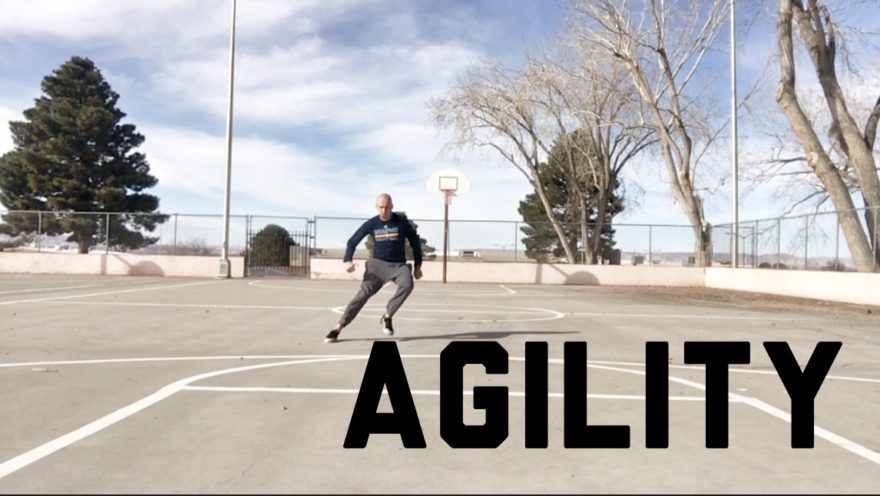I utilize a notecard system to help me organize similar material I come across from various resources. My intent is to share and continually update these notecards for you.
This notecard is all about teaching the components of agility.
Table of Contents
Keys to Change of Direction
Change of direction is all about changing angles1. We are changing the angle at which we are moving, and changing body position to allow for better propulsion into a direction different than the one we were initially traveling in.
There are two components critical for change of direction: deceleration, and reacceleration
Deceleration
Deceleration is the preparatory action necessary to change direction.
Successful deceleration occurs over several steps; a smooth transition from 5th to first gear. Taking too big of a reach to recover slows the direction change1.
Split and jump stops can be used to expedite the deceleration process. Often there is a tactical advantage to this type of maneuver, as the jump stop is performed to watch a play occur2.
When landing with a jump stop, the feet ought to be parallel, and should occur on the heels to both protect the body and increase stability for the stop2.
When you don’t have to stop, using a gathering step is appropriate, in which multiple steps can be used to slow down. A great example is a basketball closeout.
As you can see in the video above, multiple steps are used to closeout to the basketball, as opposed to a jump stop.
Reacceleration
Though deceleration is critical, reacceleration is the most important component to effective direction change. The faster one can reaccelerate into a different direction, the more effective the direction change will be2.
To occur, reacceleration requires planting a leg to push off in a different direction. With the plant, the ankle and hip face the same direction and are loaded, which will help propel the athlete into a different direction. What you don’t want to do is stop and restart, which is too slow2.
Multidirectional Maneuvers
Agility composes not just change of direction, but also propeling the body in all three planes: sagittal, frontal, transverse.
Various skills that help one move in these three planes include acceleration, backpedaling, lateral shuffling, hip turns, and crossover running.
Let’s dive into each.
Acceleration
See the Acceleration Notecard.
Backpedal
Backpedals allow for getting into position to make a play2. They expand vision to allow for more events to occur in front of the individual.
Here are the keys to performing an effective backpedal:
- Low and short footaction (think push the ground away)
- Chop hands
- nose over toes
- shorter strides (can use hills if the strides are too short)
An example drill could be a 5yd I-test, in which you backpedal 5 yds, then sprint past the start
Lateral Shuffle
The 3 keys to lateral movement are:
- Enough single leg strength to stop and restart movement
- deceleration
- land with stability3
The lateral shuffle is an important maneuver for covering a lot of lateral ground, oftentimes to create a tactical advantage in sport.
Beginning a lateral shuffle involves a solid starting stance, an athletic stance. Shoulders should be over knees over toes. You want to load the position by isometrically abducting the legs. Think of “tearing a paper towel” underneath your feet2.

When shuffling, one leg pushes and the other leg pulls. In whichever direction one is traveling, the same-side leg is the momentum leg, which pulls the body laterally. The contralateral leg is the power leg, which pushes the body into the desired direction. The push always comes before the pul, and occurs along the following cycle:
Power leg pushes down & away → momentum leg lands with foot turned out to better utilize hamstrings → momentum leg pulls by digging the heel → power leg recovers
The above sequence is called the lateral gait cycle2.
First two strides within the shuffle need high force to accelerate. Thus, longer strides ought to be used. The lateral gait cycle finishes with feet underneath the athlete4.
Here is a video illustrating the lateral shuffle:
Helpful cues for the lateral shuffle include:
- Stay in the the tunnel
- push the ground away
- minimize shoulder sway2
If one is having difficulty achieving a directional step or if the shoulders excessively sway, “hot feet” drills can help make the shuffling action occur reflexively2:
I also like to use a wall or a shoe to cue pushing away with the power leg:
Crossover Runs
Crossover runs are when an individual is running, but keeping the trunk oriented towards a play4.
The run starts with a directional step towards the intended travel location. So if a crossover run occurs to the right, the directional step occurs with the right leg. This step involves externally rotating the leg, and prepares the opposite leg for acceleration4.
The opposite leg is the crossover leg. This leg crosses in front of the upper body, propelling the body into the desired direction2.
The crossover run looks like so:
Hip Turn
This action is when the trunk stays forward but legs turn diagonal, an effective method for changing direction into a lateral shuffle or a crossover run2.
The hip turn is also useful when recovering from a mistake. Taking advantage of the stretch shortening cycle, turning and pushing into the direction of the play allows for to cover more ground, recovering from the mistake2.
A good drill to practice the hip turn is the V-shuttle. In the graphic below, the client is facing north of #1. Then, the client performs a hip turn and shuffles to #2, then back to #1, then #3, then back to #1. The space between each point is about 5 yards2.
Here is a video of the drill being performed.
Cutting
There are several types of cuts one can perform to change direction. These include the speed cut, the sharp cut, the jump cut, the spin cut, and the fake cut2.
Let’s take a closer look at each cut.
Speed Cut
A speed cut is a short cut to pass an opponent’s shoulders.
Sharp Cut
A sharp cut involves planting away from the travel direction. This cut involves dropping center of gravity to allow for effective direction change2.
Jump Cut
A jump cut involves landing into a ready position for acceleration.
Spin Cut
A spin cut is when the foot closest to a defender pushes off in a new direction.
Fake Cut
A fake cut involves a quick jab away from the intended direction. Any body part, including the eyes, head, and shoulders, can be used to fake the move.
Supportive Drills
Fake throws can be used to simulate the increased momentum needed for direction change. These throws can be performed either horizontally or vertically, with arm position either at chest, half arm, or full arm level2.
Agility Drill Programming
Agility drills should last 3-7 seconds with a rest ratio of 30-75s.
Set and repetition ranges can be 3-5×5-8/7-10s, or 5-8×2-5 or 3-5s
Total volume ought to be 20-25% total volume of linear acceleration, with linear speed occuring first in the prorgram2,5.
In my opinion, teaching these skills within the athlete’s sport allows for the most transfer, and multiple skills can be linked together. Drills can then be broken down to enhance technique and correct movement errors.
If playing the game is not realistic given a clinician or coach’s facility, reactive games can act as a surrogate, albeit with less transfer. These games can include chase, tennis ball grabs, and tag4.
It is also recommended that for any agility drill, sprints should be used to finish, since often change of direction is used to sprint in a different direction5.
Sum Up
Agility is a matter of building certain skillsets that ultimately allow for propelling oneself into a different direction. Master these skills allows for sooner usage of linear speed, helping the play be made.
To summarize:
- Change of direction is about changing angles
- Reaccelerating as quickly as possible is the most important piece of direction change
- Skills such as shuffles, crossover runs, and hip turns utilize non-sagittal planes to alter the direction one is traveling in
- Cutting is an essential skill to quickly change direction
- Agility drill should be short in duration, performed after linear speed, and ought to finish with a sprint.
Which techniques and resources do you draw from to improve agility? Comment below and I can add to this notecard.
References
- Dan Pfaff. Altis Apprenticeship Coaching Program. 2016.
- Lee Taft. Certified Speed and Agility Coach. Online. 2016
- Mike Boyle. New Functional Training for Sports. 2nd edition. 2016.
- Lee Taft. Physical Preparation Summit. 2012.
- Derek Hansen. Private Seminar. 2017.

Hi coach, you have elaborately explained the process of becoming more agile here. This is one touchy area which very few coaches want to address especially when most believe that agility can’t be taught or all the fancy footwork drills won’t help one become better at exhibiting agility in real world situations. I really liked your presentation and thank you for the info.
Sham. Great question my guy. I’m going to add it to my list on the movement debrief questions. I will answer this at some point!
Be on the lookout and appreciate your readership!
Z